Brussels, 11 October 2001
Bridging the Waste Gap
The Bridge to
Sustainability
Association for Sustainable
Use and Recovery of Resources in Europe (ASSURRE) Conference
Domingo Jiménez-Beltrán
Executive Director
European Environment Agency
Copenhagen
Ladies and Gentlemen,
It is a great honour to be asked to deliver the keynote speech at
such a distinguished gathering. I am most grateful to the organisers
for inviting me here today.
It is particularly encouraging that ASSURRE, as its name indicates,
is seeking to shift the focus of debate and action away from mere
management of waste and onto the wider challenge of sustainable
management of resources. This is exactly the sort of development that
is needed in the business sector more generally if sustainable
development is to become a reality.
We must move away from the idea of waste management as a
self-perpetuating economic sector if the goals of preventing and
minimising waste generation are to be reached. We need waste managers
to become resource managers. It is my hope that in the near future, to
paraphrase a well-known song, there will be no business like the
sustainable resource management business!
As many of you will know, the European Environment Agency is an
independent European Community body which has the core task of
providing timely, targeted, relevant and reliable information to
support protection and improvement of the environment and the
achievement of sustainable development.
We do this by collecting data on the current and foreseeable state
of the environment, assessing it and turning it into information that
can be used by policymakers. In the overload of information available
about the environment and sustainable development, we focus our
reporting on what is essential to support the policy process. Besides
our reporting activities, we are also active in disseminating
information on best practice on the environment and sustainable
development.
Accurate and usable information is the fundament of any bridge to
sustainability. Without it, the bridge either won't get built or it
won't hold up long enough for us to get there.
Most of the Agency's information is available through our website at
www.eea.europa.eu. The site has
developed into an important and wide-ranging online resource and I
would invite you to make extensive use of it if you do not already do
so.
Let me just underline that our remit is not only European but
pan-European.
For several years we not only shared the acronym EEA with the
European Economic Area but also had the same member countries.
However, in August of this year we became the first EU body to
enlarge to the east and south when six of the candidate countries
joined our ranks. Since then four more have ratified their membership
of the Agency. We hope that most if not all of the other candidate
countries will do so by the end of this year and that we can start
integrating all of these countries fully into our activities from the
beginning of 2002.
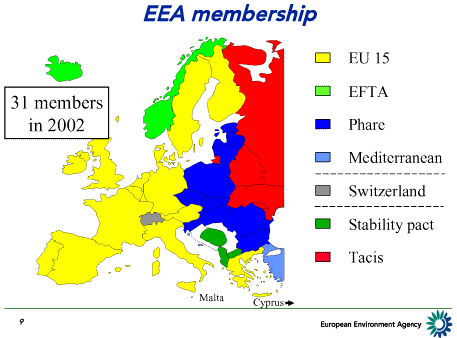
The Agency has of course been working with most of the candidate
countries since 1996 on specific projects with support from the PHARE
programme. However, Agency membership will give the candidate countries
the tools both to monitor their environment consistently and to measure
how effectively the new environmental laws they are introducing ahead
of EU membership are being implemented.
For the EEA, the more regular flow of data and information that will
result from their full integration into our activities will allow us to
improve the coverage and quality of the environmental and sustainable
development assessments we provide to policymakers.
To complete the jigsaw puzzle of our membership, I should mention
also that negotiations have started with Switzerland with a view to its
eventually joining the Agency.
Ladies and gentlemen, sustainable use and management of resources is
an important new paradigm that shifts the focus of action beyond waste
and into such areas as material flows and resource productivity.
Unfortunately, the vast amounts of waste we are still confronted
with are a clear indicator of how far we still have to go to achieve
sustainability in resources use.
What is the waste situation today? It is actually not easy to get an
accurate picture of the situation in Europe, even within the EU. The
problem is the limited data available, their limited relevance and
consistency, and to differences in the definitions of waste used in
different countries. The EEA often has to estimate trends based on data
from a limited number of countries.
The ”waste gap” is as much an information gap as a gap between
ambition and current reality.
Even as we seek to go beyond waste we still need better waste
statistics, but they have to be statistics with a purpose. They have to
be statistics that directly serve the policy framework, not statistics
that tie up untold numbers of government officials in needless
number-crunching.
The proposed EU waste statistics regulation should bring dramatic
improvements in this regard. We can only hope for its adoption by the
Council and Parliament as soon as possible.
As our report Environmental signals 2001 shows, the limited
data that are available indicate that waste generation in the EU is
continuing to increase and remains closely linked to economic growth. I
hardly need point out that this trend is at odds with the general
objective of waste prevention.
The total generation of waste in the EU amounts to some 1,300
million tonnes a year. Manufacturing, mining and quarrying are the
biggest sources of waste. The limited data available show that waste
quantities from manufacturing seem to be constant or in some cases
falling while those from all other sources are increasing.
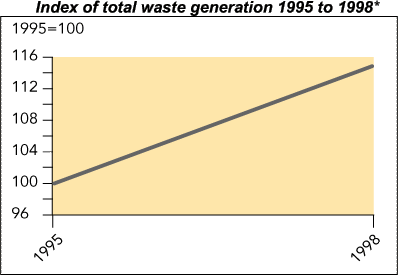
*Based on a selection of illustrative national trends (Denmark,
Ireland and Italy).
As with many other environmental issues, the challenge we all face
is to decouple waste generation from economic growth.
There appears to be a close link between economic activity and the
generation of construction and demolition waste. In the manufacturing
sector it seems, on the basis of field studies, that while use of
cleaner technologies is reducing waste generation per unit of
production in some countries, these gains are being overwhelmed by
growth in the quantity of goods consumed.
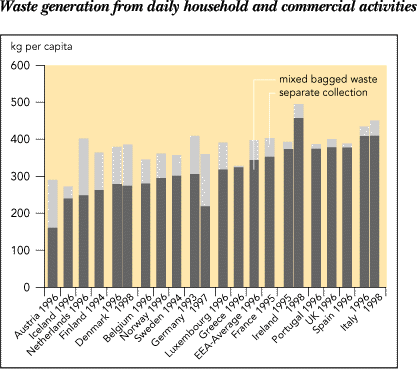
One of the targets set in the Fifth Environmental Action Programme
(5EAP) was to stabilise the generation of municipal waste at the
average EU level of 300 kg per person by 2000. But the data show that
in 1996 each person in the EU produced 400 kg of waste from daily
household and commercial activities alone, which are only part of the
municipal waste stream. This, together with the trend of increasing
waste generation in countries for which data are available, suggests
that the 5EAP target is far from being reached.
Some countries, especially in southern Europe, continue to use
landfilling as the principal method for dealing with biodegradable
municipal waste. They will face considerable problems in meeting the
reduction targets set in the landfill directive.
From Gothenburg to
Barcelona -- how to measure and manage sustainability
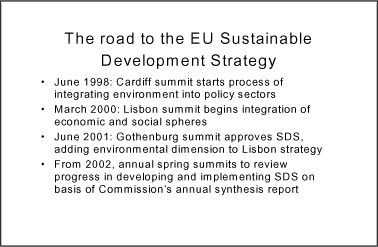
The past three years have seen a major evolution in high-level
policy developments on environment and sustainable development within
the EU.
The June 1998 Cardiff summit of EU leaders put sustainability
thinking on to a faster track by starting a process of integrating
environmental considerations into sectoral policies, such as transport,
agriculture, the internal market and even foreign relations.
Sustainability thinking then advanced rapidly during Sweden's EU
presidency in the first half of this year. First, the Stockholm summit
in March committed EU leaders to adopting a sustainable development
strategy that would add the environmental dimension to the process of
bringing together the social and economic aspects of development that
was begun at Lisbon in March 2000.
Then a sustainable development strategy was agreed by the Commission
and presented to the Gothenburg summit in June, which in turn issued
conclusions on it and launched the process of implementing and further
developing it. Implementation is to be reviewed at the EU's annual
spring summits, starting at Barcelona in March 2002. The EU leaders
also asked at Gothenburg for the environmental integration strategies
that have been developed for the various economic sectors under the
"Cardiff process” to be finalised and implemented in time for the
Barcelona summit.
Gothenburg thus concluded a process of bringing together the three
pillars of sustainable development - economic, social and environmental
-- in an integrated policy framework. It also marked the beginning of a
new policy-making approach based on the principle that the economic,
social and environmental effects of all policies should be examined in
a coordinated way and taken into account.
The sustainable development strategy singles out a number of
objectives and measures as general guidance for future policy
development in four priority areas. These are:
- Combating climate change
- Ensuring sustainable transport
- Addressing threats to public health; and
- Managing natural resources more responsibly.
As far as this last area is concerned, breaking the links between
economic growth, the use of resources and the generation of waste is a
key headline objective. As you see we are far from achieving this but
there appears to be a clear determination to move in this direction as
shown by the Commission's initiative to develop an Integrated Product
Policy in cooperation with business to reduce resource use and the
environmental impacts of waste.
What is also important is that the Commission has taken the
initiative to develop the tools and indicators to manage the policy to
pursue this objective and make it accountable. The Commission will
propose a system of resource productivity measurement to be operational
by 2003.
This links up with the goals pursued under the thematic strategy on
the sustainable use and management of resources planned under the Sixth
Environment Action Programme, as reflected in the Council's common
position. This include the development of:
- an estimate of materials and waste streams in the Community,
including imports and exports, for example by using the instrument of
Material Flow Analysis
- the establishment of goals and targets for resource efficiency and
resource use reduction, breaking the link between economic growth and
negative environmental impacts
- indicators of resource efficiency.
Developing and using indicators to assess and then report on the
degree of progress made towards achieving policy goals is where the
European Environment Agency comes into the picture.
Indicators can play a valuable role within the preparation and
evaluation stages of the policy cycle. Their importance becomes clear
when we bear in mind that we can manage only what we can measure.
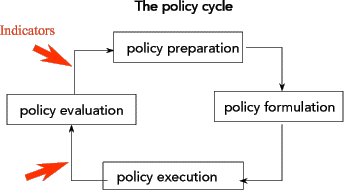
By demonstrating the extent of progress achieved, indicators create
transparency and make policymakers accountable for the success or
otherwise of their policies. In providing the basis for reporting on
progress towards meeting sustainability objectives, indicators will
thus be a key tool in managing sustainability.
As you may be aware, the European Commission will evaluate
implementation of the sustainable development strategy by adding a
number of headline sustainability indicators to the structural
indicators contained in the "synthesis” report on economic and social
integration that it produces early each year.
The expanded report will enable the spring summits of EU leaders to
review progress in developing and implementing the sustainable
development strategy. The summits will give policy guidance as
necessary.
As we have already seen, the key sustainability objective in the
area of waste and resources is that of "managing natural resources more
responsibly”.
The initial choice of indicators to measure progress towards this
objective will be determined to a large extent by the availability of
data. Two indicators that are seen as immediately feasible are being
considered for use in the short term. However, they are purely
waste-focussed. The two are ‘Municipal waste collected, landfilled and
incinerated' and ‘Recycling rate of glass, paper and cardboard'.
I understand that the European Commission is aiming to propose the
set of sustainability indicators to be used at the Barcelona summit
within the next few weeks. The EEA looks forward to taking
responsibility for producing a number of these indicators.
The Agency is also working with our partners in the other EU
institutions to establish an interlinked system of indicator sets to
follow progress in the various policy "corridors” that come together in
the sustainable development strategy.
The sustainability indicators will be embedded in a wider set of
indicators that will, for example, allow us to assess progress towards
meeting the specific subtargets mentioned in the 6th Environmental
Action Programme (6EAP) and the specific thematic strategies that will
follow on sustainable use of resources, waste recycling and other
themes.
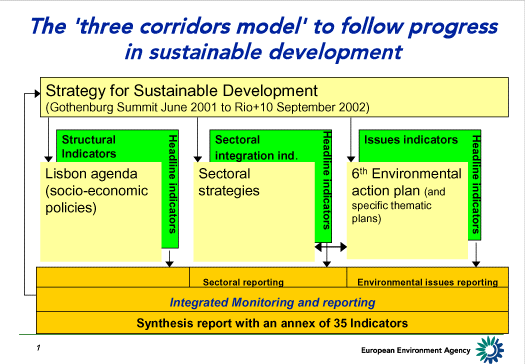
The EEA's annual indicator-based report Environmental signals
will develop into a multi-purpose tool for reporting overall progress
on issues and sectors. The next edition, Environmental signals
2002, is being developed in good time to feed into the early stages
of preparation of the synthesis report for Barcelona. Signals
2002 will be published in the spring and will contain both the main
indicators needed for the synthesis report and a selection of
background indicators in a structure and logic that will seek to serve
wider needs.
A strategic approach to
improving resource recovery and efficiency
As I've noted, the two indicators that are being considered for use
in the short term to measure progress towards the sustainable
development strategy's goal of "managing natural resources more
responsibly” look only at waste.
To help us move beyond waste and towards sustainable management and
use of resources, we will need to look for other ways of measuring
progress in the medium to long term. One relatively new indicator we
believe would be useful is Total Material Requirement (TMR), which we
calculated for the first time in our Environmental signals 2000
report.

What is TMR? TMR measures the mass turnover of all domestic and
imported primary materials that are extracted from nature to support
human activities. It indicates the extent of environmental impacts
associated with resource extraction, materials and energy use and
generation of emissions and waste. In short, TMR makes it possible to
calculate the EU's overall burden on the world environment.
Earlier this year the Agency issued a report based on the first
calculation of TMR for the EU as a whole, undertaken for us by the
Wuppertal Institute. It showed that the EU countries have made little
headway towards preventing economic growth from translating into higher
natural resources use. The EU's material requirements have been growing
almost as fast as the economy.
Between 1995 and 1997 TMR rose by 3% from 18.1 billion tonnes to
18.7 billion. The increase was due entirely to increased imports of
materials, particularly precious metal ores, whose extraction creates
large volumes of mining waste.
This first calculation up to 1997 shows us that around 50 tonnes of
materials a year have to be extracted from the Earth to support the
lifestyle of each EU citizen -- much less than the US level of 84
tonnes in 1994 but above Japan's level of 45 tonnes that same year.
We have made only limited progress towards improving the efficiency
with which we use those resources, or what is called "material
productivity.” Between 1988 and 1997 TMR per capita in the EU rose by
11% while the economy grew by 18%. This means there was some decoupling
of TMR from economic growth but not to any significant extent. It is
worth noting that Japan's lower TMR but higher economic growth in per
capita terms means that its material productivity is some 1-1/2 times
higher than the EU level.
The shift to sustainability will surely mean using less materials
and energy but using them more efficiently -- a shift from quantity to
quality, one could say. To guide us we will need some kind of
"sustainability compass.” TMR can be helpful in showing how
successfully we are following the compass's directions.
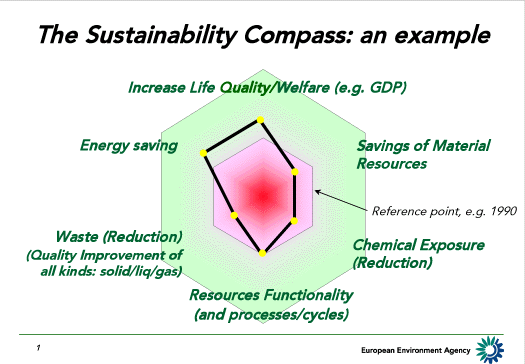
Ladies and gentlemen, the task of working towards Gothenburg's goal
of managing natural resources more responsibly falls to all policy
sectors as they continue the "Cardiff process” of integrating
environmental considerations into their thinking. However, for now the
most detailed set of goals and actions in this area comes from the
6EAP.
How is the European Environment Agency supporting the 6EAP?
With the help of our Topic Centre on Resource and Waste Management
we are currently developing a conceptual framework for Resource and
Waste Management from which a core set of relevant indicators will be
derived. The framework will reflect our twin aims of improving
information about the current and future waste situation while at the
same time assisting the shift "beyond waste” into the area of
sustainable use of resources.
The indicators will need to be sufficiently relevant, robust and
reliable to make it possible to evaluate the environmental performance
of the 6EAP and the thematic strategies on sustainable resource use and
waste recycling that will flow from it. The effects of legal
instruments such as the directives on packaging, landfill, end of life
vehicles and waste from electrical and electronic equipment will also
need to be evaluated.
Particular emphasis will be placed on the causal link between
resource use and the generation of waste. And the conceptual framework
will supplement data collection -- the "classical” approach to
information gathering -- with modern information assessment tools and
methods.
Suitable indicators will be needed on material flow accounting, a
methodology that follows materials from their origins to their end use
and which should allow us to start ‘closing the loop' of inputs and
outputs.
Simple models using coefficients for material inputs and waste
outputs for economic processes will be developed. These will provide
insights into how to design a closed loop economy that prevents or
minimises waste generation.
The Agency is also working in the field of predicting future trends
in waste generation and assessment of dangerous substances emitted into
the environment by waste treatment and disposal. A computer model has
been developed and tested on an important waste stream, namely waste
from electrical and electronic equipment. The model is currently being
evaluated and modified to make it applicable to other waste streams as
well.
The aim of this initiative is to prepare an integrated model which
can help the Agency and its clients, such as DG Environment and
national authorities, to assess all major questions associated with any
waste stream, including forecasts of future waste quantities and the
preparation of scenarios.
Ultimately, by applying the set of indicators, information
assessment tools and models I have described, we should be able to
- Assess waste quantities produced by major economic activities and
relevant emissions of dangerous substances
- Analyse economic activities by using material flow analysis and
allocate waste quantities at each stage of the production process
- Predict future trends in waste generation and prepare "what if”
scenarios
- Describe the most important environmental impacts caused by waste
collection, treatment and disposal
- Evaluate best available techniques for waste
prevention/minimisation and the effectiveness of policies and measures
implemented.
It should at last become feasible to make reliable predictions of
waste quantities and impacts caused by various activities on the basis
of reliable socio-economic data, for instance on industrial production,
without the need for accurate basic data collection. We hope to reach
this position in around five years' time.
In the more immediate future, we will be publishing reports over the
next few months on a number of resources- and waste-related topics that
I hope will be of particular interest to this audience. These will
cover:
- Specific aspects of waste minimisation
- Strategies and instruments related to organic waste
- Emissions from various waste treatment schemes, and
- Construction and demolition waste and other waste streams.
Finally, ladies and gentlemen, permit me to mention briefly our
activities regarding best practice.
We promote best practice through printed publications but, more
importantly, through a feature on our website called EnviroWindows, a
cost-free information resource for businesses, local authorities and
their stakeholders.
Through sets of "portals” linking mainly to information from outside
the EEA, EnviroWindows facilitates public access to information on
companies' products, best practices, use of natural resources and
environmental performance. It also helps local authorities to
communicate with concerned citizens, professionals, policy makers and
companies.
Current participants include, for example, business networks
promoting exchanges of experiences in cleaner production and
benchmarking of industrial environmental performance.
Sharing best practice information is essential for accelerating the
transition towards sustainable development and EnviroWindows is an
excellent platform for doing so. We are continually developing
EnviroWindows and would be delighted to welcome ASSURRE and other
business groups dedicated to sustainable resource management as
participants.
Providing opportunities for people to do better, and to share their
experiences, reflects the EEA's preferred approach of focussing on what
to do rather than what not to do as society strives for
sustainability.
I thank you for your kind attention.
File for download:
The speech, 11
October 2001 [152 Kb PDF]
[top]









Document Actions
Share with others